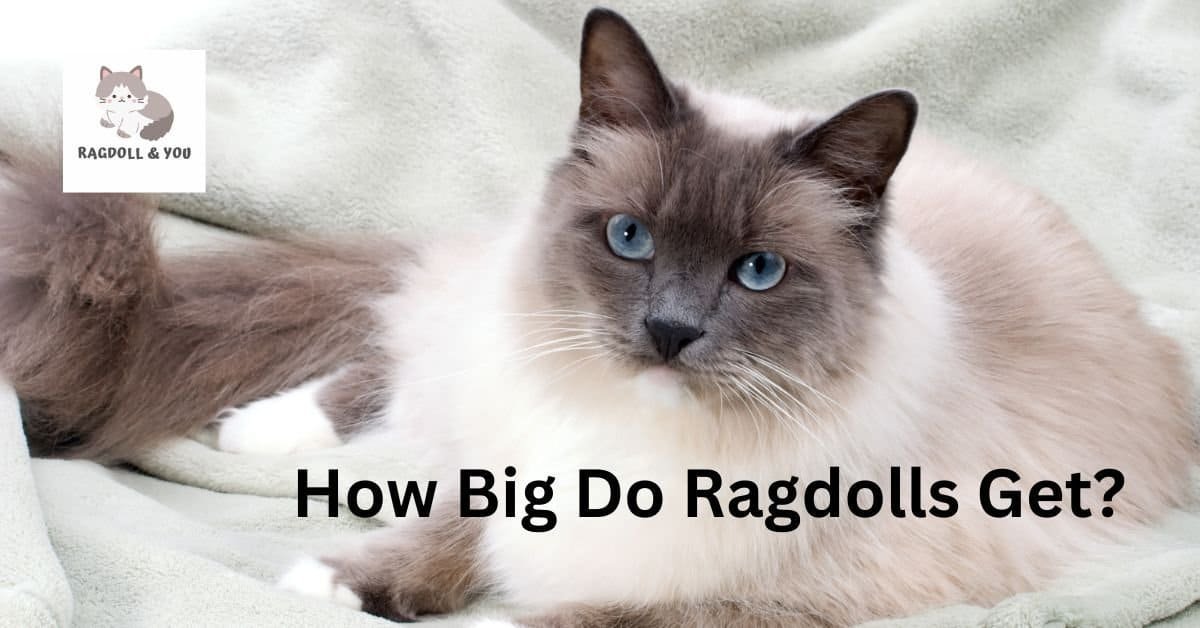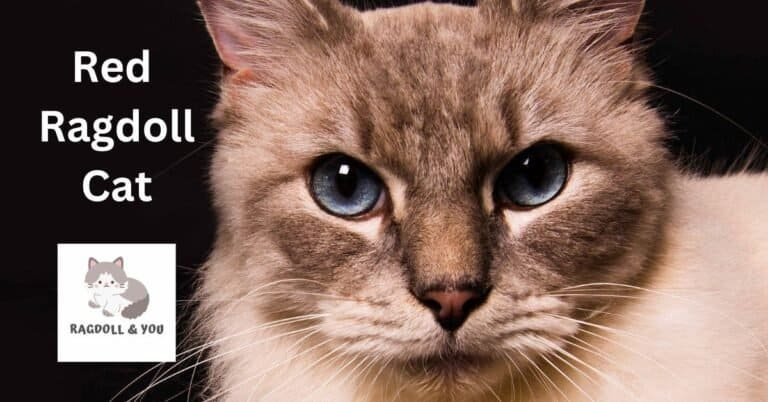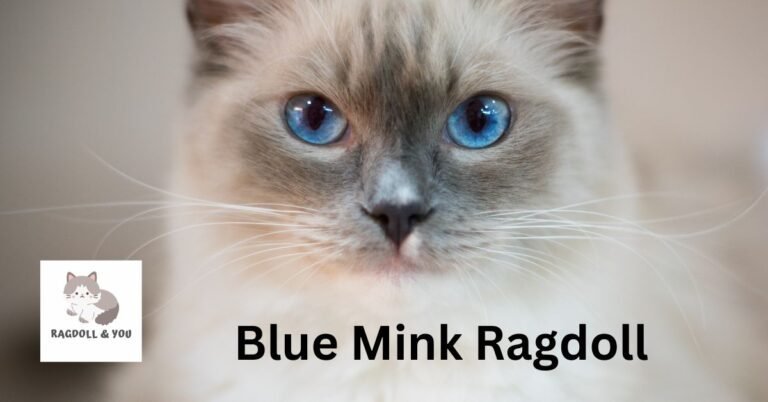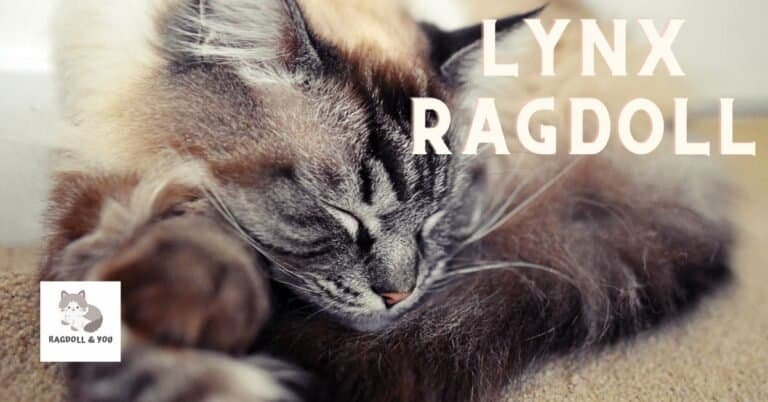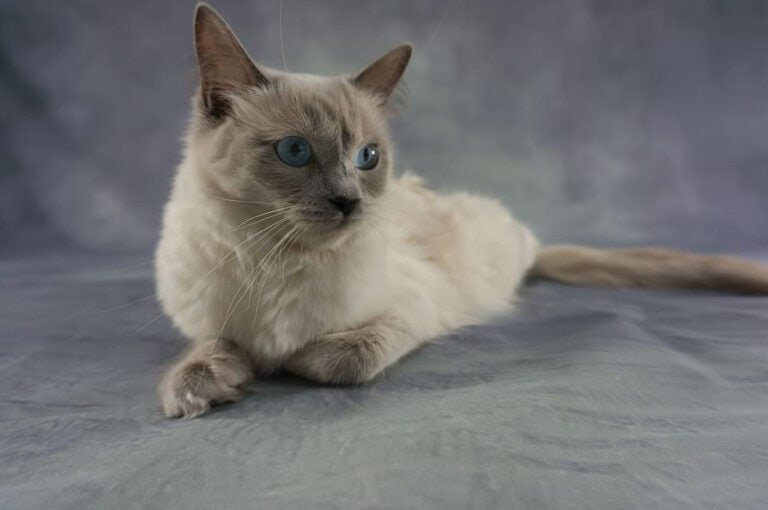How Big Do Ragdoll Cats Get: Ragdoll Size Guide
The cuddly Ragdoll kitten is a perfect blend of charm and size. Ragdolls are among the largest domestic cat breeds known for their impressive adult size. Female Ragdolls weigh around 8 to 15 pounds and males around 12 to 20 pounds. They can take up to four years to completely mature and get really massive reaching 9-11 inches in height.
Overview of Ragdoll Cats
Ragdoll cats are a popular breed of cat with a larger size and gentle temperament. You’ve come to the right place if you wonder how big these furry companions can get. Here is an overview of Ragdoll cats, from their growth chart to factors that influence their size and weight.
Compare them to other breeds of cats, explore why they get so big, and get tips for healthy growth for your Ragdoll cat. Learn everything about the impressive adult size of these amazing felines!

History
The Ragdoll cat breed is relatively new, developed in the United States in the 1960s. The breed’s founder, Ann Baker, claimed that the Ragdoll was created by crossing a Birman with a Persian.
Baker began breeding Ragdolls in 1963, and she trademarked the name “Ragdoll” in 1965. She was a strict cat breeder and tightly controlled Ragdolls’ breeding.
This led to some controversy within the cat fancy. In the 1970s, several breeders broke away from Baker and formed their registries.
Today, the Ragdoll is one of the most popular cat breeds in the world. They have gentle temperaments and a tendency to go limp when picked up, earning them the nickname “ragdolls.” It is a puppyish personality, making them more unique.
Here are important events in the history of these largest breeds of cats:
- 1960: Ann Baker begins breeding Ragdolls.
- 1963: Baker trademarks the name “Ragdoll.”
- 1971: The International Ragdoll Cat Association (IRCA) is founded.
- 1998: The Cat Fanciers’ Association (CFA) recognizes the Ragdoll breed standard.
Appearance
These domestic breeds are big and strong. Their long, well-built body has a lot of muscle. They have long, soft fur that feels like silk and helps them regular their body temperature.
The coat color is light but still very pretty. Males are often taller than female Ragdolls, with heights around 9.5″-11″.
Female Ragdoll cats usually measure between 9″ and -10″. What makes them special is their large blue eyes, glowing beautifully against their plush coat color.

Coats and Patterns
Ragdoll cats have long, soft fur in a variety of colors and patterns. Ragdolls’ most common coat color is seal point, followed by blue point, chocolate point, and lilac point.
These point colors are caused by a recessive gene that affects the pigmentation of the cat’s fur. The points are darker than the rest of the cat’s body, typically including the face, ears, legs, and tail. Other single coat colors less common in Ragdolls include
- Flame Point: This color is similar to seal point, but the points are lighter and have a reddish tinge.
- Tabby Point: This color has the same point pattern as other Ragdolls, but the points are striped.
- Snowshoe: This color has a white body with points on the face, ears, legs, and tail.
- Bicolor: This color has a white body with points on the face, ears, legs, and tail. A solid color is present on the chest and stomach.
- Van: This color resembles bicolor, but the white area extends to the shoulders and hips.
Ragdolls can also have a variety of patterns, including:
- Solid: This pattern has no markings.
- Tabby: This pattern has stripes.
- Lynx point: This pattern has a tabby pattern on the points.
- Harlequin: This pattern has a larger size of white patches on the body.
- Mitted: This pattern has white paws.

Temperament
Ragdoll cat personality can be described as calm and quiet. They show love to everyone, even kids and other pets.
Their high intelligence and activity level helps them learn things quickly, making them train easily. Their voices are soft and sweet, not loud or bossy.
This means they do not meow much as other common breeds do. Ragdolls have a nice nature that helps them fit into any home.
Care and Health
Ragdoll cats need extra care to stay healthy. They shed their silky coat two times a year, so daily combing is important. Bathing help keeps their fur clean and soft. A Ragdoll’s regular grooming needs include nail trimming and ear cleaning.
These cats should eat high-quality dry or wet foods. Overeating can lead to obesity, which is bad for their health. Regular vet checks will catch any health conditions early on.
Some risks include heart disease (HCM), chronic kidney disease, dental disease, and urinary tract issues.
Ragdoll Cat Growth Phases
These giant cat breeds undergo various growth phases. It includes changes in the first four weeks and rapid growth from the 5 to 12-week mark. Their kittenhood is from 3 to 6 months of age, and they grow into adults between 6 and 12 months.
Newborn Ragdolls: Changes in the First 4 Weeks
Newborn Ragdolls undergo many changes in the first 4 weeks. During this period of time:
- They rely on their mother’s milk for nourishment.
- Their eyes and ears remain closed.
- They can’t walk or stand and crawl around using their front legs.
- Their sense of touch is developing, and they become more aware of their surroundings.
- Their fur starts to grow, which may be a different color than their adult coat.
- They experience excessive weight gain, doubling their birth weight in just a few weeks.

Rapid Growth: Weeks 5–12
During weeks 5-12, your Ragdoll kitten will experience rapid growth.
- Weight Gain: Your kitten will continue to gain excess weight in earlier weeks. They may double their birth weight during this time.
- Size Increase: You will notice that your kitten grows bigger weekly. Their body length, height, and newborn size will become more apparent.
- Developing Muscles: As your kitten’s sturdy bodies grow, its muscles become stronger. This is an important part of their physical development.
- Increased Energy Levels: With rapid growth comes increased energy levels. Your kitten will become more playful and active during this stage.
- Maturity Milestones: Around the end of this phase, your kitten’s baby teeth will start falling out, making room for their adult teeth. They may also begin scratching on surfaces like scratching posts.
- Nutritional Needs: Proper nutrition is crucial during this period of rapid growth. Ensure a proper diet specifically formulated for kittens to support their growing bodies.

Kittenhood: 3–6 Months
The kittenhood stage lasts 3 to 6 months. Ragdoll cats continue to grow and develop during this time.
- As per 3-month Ragdoll size, male kittens weigh around 1.5-2.2 kg (3.3-4.8 lbs). The 3-month standard cat size for females is around 1.3-2.0 kg (2.9-4.4 lbs).
- By 4 months old, male Ragdolls weigh about 2.5-3.5 kg (5.5-7.7 lbs). Females weigh about 2.3-3.0 kg (5.0-6.6 lbs).
- At 5 months old, males usually weigh 3.2-5.0 kg (7.0-11 lbs). Females weigh 2.5-3.5 kg (5.5-7.7 lbs).
- When 6 months old, males typically weigh around 3.5-5.5 kg (7.7 -12. lbs), and females weigh around 2.

Growing Into Adults: 6–12 Months
During the 6-12 months time frame, a Ragdoll kitten starts transitioning into an adult cat.
- Ragdoll cats continue to develop and grow during this time.
- They may experience growth spurts, increasing their newborn size and weight rapidly.
- By 6 months old, Ragdoll cats are generally closer to their adult height and length.
- Their bodies continue to fill out and help them become a more muscular breed.
- Ragdolls reach a significant portion of their adult weight by 1 year old.
- This phase is crucial for their socialization and training as they become more independent and curious. Use positive reinforcement for maximum benefit.

Factors that Influence Ragdoll Cat Size and Weight
Various factors like colostrum intake, correct nutrient intake, exercise, and disease can influence cat size and weight.
Colostrum Intake
Ragdoll kittens must receive enough colostrum from their mother after birth for proper development. Colostrum is the first milk produced by the mother cat. It’s rich in important nutrients that strengthen the kitten’s immune system.
Insufficient colostrum intake leads to improper development and nutrient deficiencies in Ragdoll kittens. A reputable breeder ensures that newborn Ragdolls have access to their mother’s colostrum within the first few hours of birth.
A veterinarian should be consulted if there are concerns about colostrum intake or if a kitten is orphaned. They will guide you on appropriate nutrition and supplements for healthy growth.
Correct Nutrient Intake
A correct nutrient intake ensures a healthy growth chart for your adult Ragdoll cat. Meat-based special diets with animal protein and fat are essential for their nutritional needs.
Good animal protein sources for cats include mackerel, chicken, turkey, and salmon, which have a high biological value.
Avoid overfeeding your Ragdoll as they are prone to obesity, which can lead to various health issues. Following these guidelines and providing quality dry kibble can promote optimal growth.
Exercise
Regular exercise helps Ragdoll cats maintain a healthy weight and prevent obesity-related and heart issues. Engaging in playtime activities, like chasing toys or climbing cat trees, will keep them active and fit.
Provide at least 20-30 minutes daily exercise for your Ragdoll cat. This can be done through interactive play sessions or by providing stimulating toys.
Regular exercise helps with ideal weight management and also promotes good heart health.

Disease
Ragdoll cats are prone to certain diseases that can affect their health. One common disease is hypertrophic cardiomyopathy (HCM), which affects the heart muscles. It can lead to breathing difficulties and sudden death.
Another issue that Ragdolls may face is urinary tract issues, like infections or blockages. It can cause discomfort and require medical intervention. Ragdolls tend toward obesity. It increases the risk of health problems like arthritis, diabetes, liver disease, joint issues, and cancer.
Comparing Ragdoll Size to Other Cat Breeds
Ragdolls have an impressive size, often surpassing other cat breeds. Find out how Ragdoll cats measure up to a Maine Coon and the world’s smallest cats in terms of size and weight!
Ragdoll vs. Maine Coons
Both Ragdoll and Maine Coon cats have similar average sizes. But there are some key differences between these giant cat breeds.
| Ragdoll | Maine Coon | |
| Full-grown weight | Ragdolls can weigh between 10-20 pounds when fully grown. | Maine Coon is generally heavier, often weighing between 15 and 25 pounds. |
| Growth rate | Ragdoll cats grow quite slowly, typically reaching full maturity around 4 years of age. | Maine Coons also grow slowly and may not reach full size until 3 to 5 years old. |
| Gender size differences | Male Ragdolls are larger cat breeds and heavier than their female counterparts. | In Maine Coons, males have a larger size and are heavier than females. |
| Appearance | Ragdolls have a muscular build with a broad chest and large hindquarters. | Maine Coon breed characteristics include robust bone structure and rectangular body shape. |
Both giant cat breeds have an affectionate and friendly demeanour. It makes them a perfect animal companion. Regarding size variation, Maine Coons typically weigh more than Ragdolls.

Ragdoll vs. the World’s Smallest Cats
Contrasting Ragdoll and the world’s smallest cats can reveal stark differences in size variation.
| Cat Breed | Average Weight | Average Height | Average Body Length |
| Ragdoll | Males: 12-21 lbsFemales: 8-15 lbs | Males: 9.5″-11″Females: 9″-10″ | Males: 18.5″-21″Females: 17″-19.5″ |
| World’s Smallest Cats (e.g., Singapura) | 4-8 lbs | 6″-7.5″ | 9″-10″ |
These comparisons illustrate that Ragdoll cats are larger and heavier than the world’s smallest cats, like the Singapura. Despite their size difference, each breed showcases its unique charm and appeal.
Why Ragdoll Cats Get So Big?
Ragdoll cats get so big because they grow longer than other cat breeds. While most of these gentle giants reach their full size by around 12 months, Ragdolls grow until 4 years old. This extended growth phase allows them to develop larger and more muscular bodies.
The genetic mutation also plays a role in determining the size of Ragdoll cats. This giant breed was originally developed through selective breeding, focusing on creating larger, heavier cats with a gentle temperament.
Selective breeding practices have contributed to the large size of Ragdolls.
While Ragdolls can be big, it doesn’t mean they are overweight or unhealthy. Proper nutrition, exercise, and regular veterinary wellness care ensure a healthy growth chart for these big and beautiful feline companions.
How to Ensure Healthy Growth for Your Ragdoll Cat
Properly feed your Ragdoll with high-quality nutrition and provide extra care to ensure healthy growth.
Feeding Your Ragdoll For Healthy Growth
Feed them a meat-based diet that meets their nutritional needs. This means providing Ragdolls with high-quality cat food intake rich in animal protein.
A good diet can minimize shedding and hairballs while promoting coat softness and strength. Be mindful of their portion sizes and avoid overfeeding. A few extra calories can increase their weight fast.
High-quality pet food ragdolls options include Royal Canin Dry Cat Food, Canned Cat Food, etc. Read the food packaging guidelines before feeding your cat.
High-Quality Nutrition To Avoid Common Ragdoll Health Issues
To keep your Ragdoll cat healthy and prevent common health issues, provide them with high-quality nutrition. This means feeding them a diet rich in animal protein and fat as the main energy sources.
Meat-based diets are easier for Ragdolls to digest and provide essential amino acids that support their growth. A diet like this can also minimize shedding and hairballs while promoting a resilient coat length and quality.
Be mindful of your Ragdoll’s dietary needs because they can be sensitive to stomach issues, urinary tract diseases, and weight problems.
Choosing a grain-free diet with zero carbs can prevent weight gain and keep your Ragdoll lean and muscular. Dry Grain-Free Kitten Food by Wellness or Orijen Dry Food are other high-quality pet food Ragdolls options.
Fun Facts About Ragdoll Size
- The name “Ragdoll” comes from how they go limp when picked up. This is due to a genetic trait that causes them to relax their muscles in a submissive position.
- Ragdolls have blue eyes. Some Ragdolls can have green or amber eyes.
- Ragdolls are a relatively new giant breed developed in the United States in the 1960s.
- Ragdolls are popular breeds for families with children. They are gentle and patient, and they make good playmates for children.
- The first Ragdoll cat was named Josephine. She was bred by Ann Baker, the woman who is credited with developing the Ragdoll breed.
- Ragdolls are not born with blue eyes. Their eyes start out pale blue and gradually darken to blue as they age.
- Ragdolls are not always as docile as they are portrayed. They can be playful and active, especially when they are young.
- Ragdolls are not hypoallergenic cats. They do shed, and their fur can trigger allergies in some people.

Accommodating a Large Cat
Provide Plenty Of Space:
- If you have a small house, create vertical space for your cat to climb and explore. This could include a cat tree or shelves that they can jump up on.
- Try placing your cat’s bed or other furniture in areas with plenty of room to move around.
- If you have a yard, ensure it is fenced so your cat cannot escape.
Get A Large Litter Box:
- A standard-sized litter box may be too small for a Ragdoll. Getting one at least 18 inches tall and 12 inches wide is important.
- Have at least one litter tray per cat, plus one extra.
- Place the litter tray or box in quiet areas where your cat will not be disturbed.
Choose Cat Furniture That Is Large Enough:
- When choosing cat furniture, ensure it is large enough for your Ragdoll to comfortably use. This includes beds, scratching posts, and cat trees.
- You can also find cat furniture designed for the largest cat breeds.
Make Sure Your Home Is Safe For A Large Cat:
- Remove any potential hazards. Small objects can choke your cat, and sharp objects can injure them.
- Keep your cleaning supplies and other chemicals out of reach of your cat.
- Secure any furniture that your cat could climb on and fall from.
Exercise Your Cat Regularly:
- Ragdolls are not very active, but it is important to exercise them regularly. This will help them stay healthy and fit.
- Exercise your cat by playing with them with toys or taking them on leash walks.
Brush Your Cat’s Fur Regularly:
- Ragdolls have long fur that can easily mat. Brushing their fur regularly removes dead hair and prevents mats.
- Among crucial cat grooming tips is to brush your cat’s fur at least once a day or more often if shedding.
Take Your Cat To The Vet For Regular Checkups:
- This is especially important for Ragdolls, as they can be prone to certain health conditions.
- Your vet can recommend a vaccination schedule and other preventive wellness care measures for your perfect animal companion.
FAQs
How Big Do Ragdoll Cats Get?
Fully grown Ragdolls typically weigh 10-20 pounds, with males being larger than females.
When Do Ragdolls Reach Full Maturity?
Ragdolls have a slow growth rate and may not fully mature until around 4 years of age.
What Is The Lifespan Of A Ragdoll Cat?
These cats have a long life expectancy, usually living between 13 to 18 years.
Are There Any Health Issues That Ragdolls Are Prone To?
Yes, Ragdolls can be prone to health problems like hypertrophic cardiomyopathy (heart conditions) and urinary tract issues. Proper quantity of food and regular care ensures happy life.
How Big Do Ragdoll Cats Typically Get?
Ragdoll cats are large in terms of size. Males reach an average weight of 15-20 pounds, and females average around 10-15 pounds.
At What Age Do Ragdoll Cats Stop Growing?
Ragdoll cats continue to grow until they are about 4. Most of their growth occurs in the first few years of life.
Are Ragdoll Cats Bigger Than Other Cat Breeds?
Ragdolls are generally larger than many other domestic breeds due to selective breeding for their size and appearance.
Can I Predict How Big My Ragdoll Cat Will Be Based On Its Parents’ Size?
Genetics plays a role in determining a kitten’s potential size. But it is not always accurate to predict the exact size of a ragdoll cat based solely on its parents’ sizes. Environmental factors and individual variation can also influence growth.

